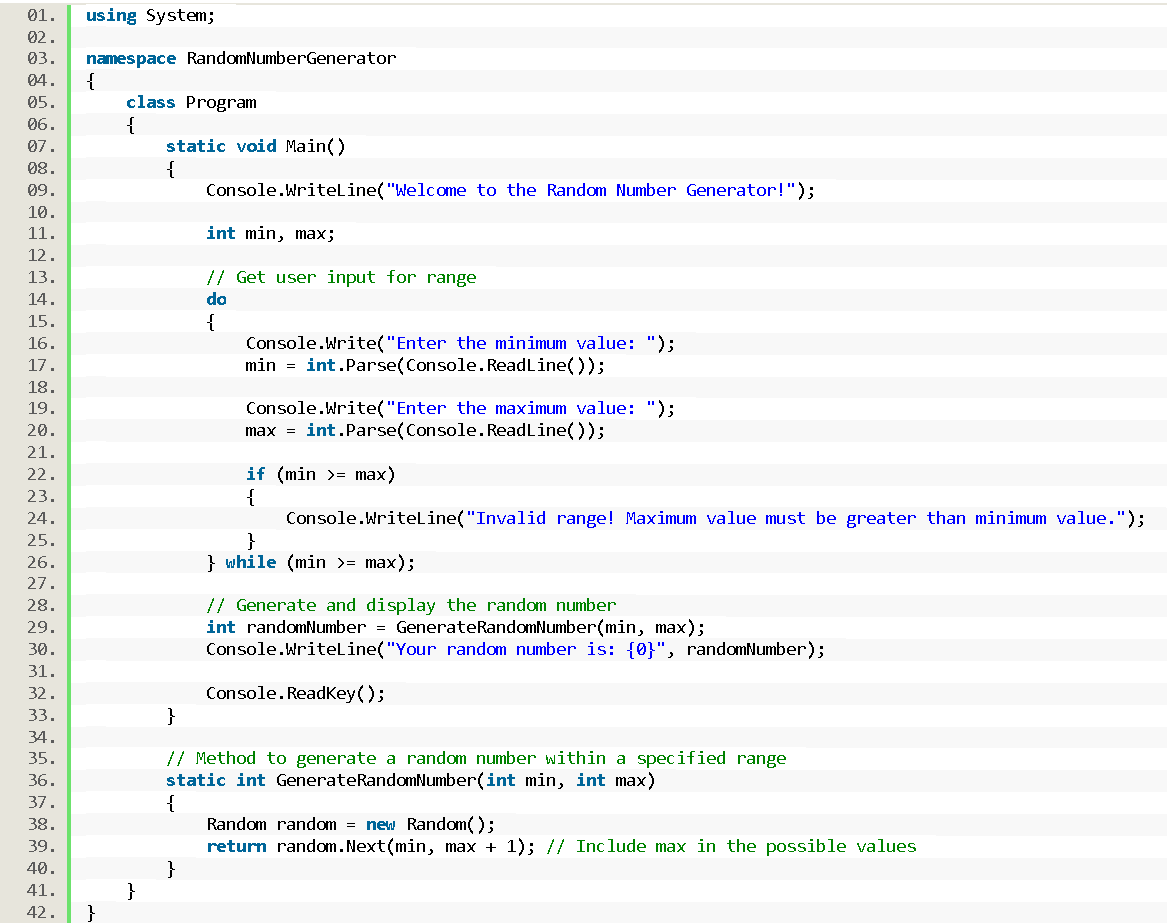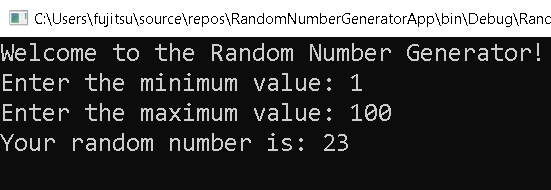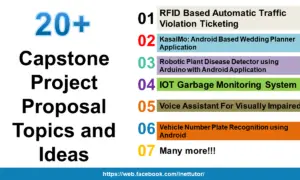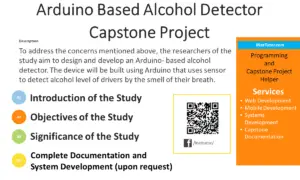Random Number Generator in CSharp
Introduction
Table of Contents
Welcome to today’s lesson on random number generation in programming. Random numbers play a vital role in various applications, from generating unique identifiers to simulating complex scenarios. In this lesson, we will explore the purpose and components of a Random Number Generator program, which allows us to generate random numbers within a specified range.
Random numbers are essential in programming because they introduce unpredictability and help create dynamic and realistic experiences. Whether you’re building a game, conducting statistical analysis, or ensuring data privacy, having the ability to generate random numbers is a valuable skill.
The Random Number Generator program we will be building focuses on generating random numbers using a method. This program will allow users to input a range and generate a random number within that range. By the end of this lesson, you will have a solid understanding of how to implement a Random Number Generator in your programming projects.
So, let’s dive in and explore the fascinating world of random number generation in programming, and discover how it can enhance your applications and projects.
Objectives
In this lesson on random number generation, we will focus on four key objectives: understanding the concept of random numbers, learning the techniques for generating random numbers in programming, practicing the implementation of a Random Number Generator program, and applying the knowledge gained to solve real-world problems.
Understanding: Our first objective is to develop a clear understanding of what random numbers are and their significance in programming. We will explore the differences between true random numbers and pseudo-random numbers, and understand why computers can only generate the latter. By grasping the concept of random numbers, we will lay a solid foundation for the rest of the lesson.
Learning: The next objective is to learn the techniques and methods available for generating random numbers in different programming languages. We will specifically focus on the Random class in Java and the random module in Python. By studying these tools, you will gain insights into the functions and methods that can be utilized to generate random numbers within specified ranges.
Practicing: To reinforce your understanding, we will provide hands-on practice opportunities. You will have the chance to implement a Random Number Generator program that allows users to input a range and generates a random number within that range. Through practical exercises, you will gain confidence in applying the concepts and techniques covered in this lesson.
Applying: Finally, we will encourage you to apply your newfound knowledge to real-world scenarios. Random number generation has various practical applications, such as generating unique identifiers, conducting simulations, or enhancing game mechanics. By exploring these applications, you will discover the versatility and usefulness of random number generation in programming.
Source code example
using System;
namespace RandomNumberGenerator
{
class Program
{
static void Main()
{
Console.WriteLine("Welcome to the Random Number Generator!");
int min, max;
// Get user input for range
do
{
Console.Write("Enter the minimum value: ");
min = int.Parse(Console.ReadLine());
Console.Write("Enter the maximum value: ");
max = int.Parse(Console.ReadLine());
if (min >= max)
{
Console.WriteLine("Invalid range! Maximum value must be greater than minimum value.");
}
} while (min >= max);
// Generate and display the random number
int randomNumber = GenerateRandomNumber(min, max);
Console.WriteLine("Your random number is: {0}", randomNumber);
Console.ReadKey();
}
// Method to generate a random number within a specified range
static int GenerateRandomNumber(int min, int max)
{
Random random = new Random();
return random.Next(min, max + 1); // Include max in the possible values
}
}
}

Explanation
Here’s a breakdown of the C# program on random number generator:
Namespaces and Classes:
- using System;: Imports the System namespace, which contains essential classes like Console and Random.
- namespace RandomNumberGenerator: Creates a namespace to organize the code.
- class Program: Defines the main class, where the program execution begins.
Main Method:
- static void Main(): This is the entry point of the program.
- Console.WriteLine(“Welcome…”);: Prints a welcome message to the console.
- int min, max;: Declares variables to store the minimum and maximum values of the range.
User Input:
- do…while loop: Ensures valid input by repeatedly prompting the user until a valid range is entered.
- Console.Write(“Enter…”);: Prompts for minimum and maximum values.
- int.Parse(Console.ReadLine()): Reads the input from the console and converts it to integers.
- if (min >= max)…: Checks for invalid range (max must be greater than min).
Generating and Displaying Random Number:
- int randomNumber = GenerateRandomNumber(min, max);: Calls the GenerateRandomNumber method to get a random number within the specified range and stores it in the randomNumber variable.
- Console.WriteLine(“Your random number is: {0}”, randomNumber);: Prints the generated random number to the console.
GenerateRandomNumber Method:
- static int GenerateRandomNumber(int min, int max): This method generates and returns a random integer within the given range.
- Random random = new Random();: Creates a new instance of the Random class to generate random numbers.
- return random.Next(min, max + 1);: Uses the Next method to generate a random integer between min (inclusive) and max (inclusive).
Key Points:
- The program demonstrates using a method to encapsulate the logic for generating random numbers, making the code more organized and reusable.
- It includes input validation to prevent errors and ensure the user provides a valid range.
- The random.Next(min, max + 1) syntax ensures that the maximum value is included in the possible generated numbers.
The GenerateRandomNumber method takes in the minimum and maximum values as parameters. Inside the method, a new instance of the Random class is created. The Next method of the Random class is used to generate a random number within the specified range. The max + 1 is used as the upper bound to include the maximum value in the possible range of numbers.
Overall, this program allows users to input a range and generates a random number within that range using the GenerateRandomNumber method. It ensures that the user enters a valid range and provides an error message if the range is invalid.
Output

Summary
The blog post starts with an introduction to the importance of random number generation in programming and its applications in various scenarios. We then outline the objectives of the lesson, which include understanding the concept of random numbers, learning the techniques for generating random numbers, practicing the implementation of the Random Number Generator program, and applying the knowledge to solve real-world problems.
Next, we explain each section of the code, including the Main method, which serves as the entry point of the program, and the GenerateRandomNumber method, which generates a random number within the specified range using the Random class.
Throughout the blog post, we provide explanations and insights to help readers understand the purpose and functionality of each code segment. We emphasize the importance of user input validation to ensure a valid range is entered and discuss the inclusion of the maximum value in the generated random number range.
To conclude the blog post, we highlight the practical applications of random number generation in programming and encourage readers to explore further and apply their knowledge to their own projects.
Exercises and Assessment
Here are some ideas to improve the source code and engage learners through exercises and activities:
Exercises:
- Expanding the GenerateRandomNumber method:
- Add an optional parameter to specify the number of random numbers to generate.
- Modify the method to generate random floating-point numbers within a specified range.
- Challenge students to implement different random probability distributions (e.g., Gaussian, Poisson).
- User interaction and validation:
- Instead of using do…while for input validation, implement a custom error message and retry loop.
- Allow users to enter the range values in a single line separated by a comma or dash.
- Add checks for invalid data types (e.g., non-numeric input).
- Applying randomness to practical scenarios:
- Write a program that simulates rolling dice or flipping a coin a certain number of times.
- Create a simple guessing game where the user has to guess a number generated within a range.
- Build a program that generates random passwords of a specific length and complexity.
Activities:
- Code review and optimization:
- Challenge students to improve the code readability and efficiency by refactoring the existing functions.
- Discuss alternatives to the Random class and their advantages/disadvantages.
- Explore unit testing the random number generation functionality.
- Collaborative projects:
- Have students work in pairs to build a game that utilizes random numbers (e.g., board game, card game).
- Organize a mini-competition where students showcase their most creative applications of random number generation.
- Encourage students to research and present real-world applications of RNG in various fields (e.g., cryptography, simulation, scientific experiments).
Additional tips:
- Break down the activities into smaller, achievable tasks to build confidence and progress.
- Encourage experimentation and problem-solving, allowing students to explore different approaches and solutions.
- Provide feedback and guidance throughout the exercises and activities.
- Connect the learning to real-world applications to demonstrate the relevance and usefulness of random number generation.
By incorporating these suggestions, you can turn the source code into a springboard for engaging and educational exercises and activities, ensuring students not only grasp the technical aspects of RNG but also have fun and apply their skills creatively.
Related Topics and Articles:
Methods in C# Video Tutorial and Source code
You may visit our Facebook page for more information, inquiries, and comments. Please subscribe also to our YouTube Channel to receive free capstone projects resources and computer programming tutorials.
Hire our team to do the project.


